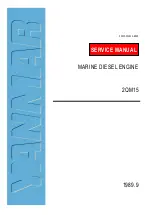
5
– English
ELECTRICAL CONNECTIONS AND FIRST
POWER UP
3
The motor has
two separate cables
: the power cable and the control cable. Each
cable has a connector for connection to the motor (
fig. 3-h
); the connectors are re-
movable and allow the possible replacement of cables (
fig. 3-i
).
CAUTION! - The
smaller cables must be handled carefully
because they contain very thin wires
that could be damaged.
CABLE “A” is the POWER cable (fig. 2)
OFF
CABLE “B” is the CONTROL cable (fig. 2)
Wire
Colour
Connection
B1
White
Voltage free contact for the Up command
OFF
B2
White-orange
Voltage free contact for the Down com-
mand / TTBus
B3
White-black
Common
CAUTION! – DO NOT connect any wires from cable “A” and “B” to the pow-
er line.
3.1 - Connecting the motor to the electrical power
supply
“The motor must be powered using a 12 V DC battery pack. To make this connec-
tion, use
Cable “A” (fig. 2)
, carefully observing the warnings indicated in the “In-
structions and warnings for installation and use” for the 12 V DC battery pack.
3.2 - Connecting accessories and sensors
• Cabled accessories
: use
cable “B”
referring to
fig. 3
and the following instruc-
tions.
– You can connect only one compatible accessory at a time to the
white
and
white-black
cables.
– You can connect only one compatible accessory at a time to the
white-orange
and
white-black
cables.
– Up to 5 tubular motors can be connected to one accessory, respecting the polar-
ity of the signals (connect the
white-black
cables of all motors together as well as
the
white-orange
cables of all motors).
• Wireless accessories
:
– These are either portable transmitters or climate sensors. For how to program/
memorise them, refer to the procedures given in this manual and in the device
manuals themselves.
PROGRAMMING AND ADJUSTMENTS
4
4.1 - Groups of programming and adjustment pro-
cedures
There are 5 groups of programming and adjustment procedures:
Group A
– done with a
transmitter.
Procedures which can only be com-
pleted with a Nice “ERA P” or “ERA
W” transmitter with the
s
,
n
,
t
,
PRG
,
ESC
keys.
Group B
– using the
buttons on the motor
head.
Manual adjustment of the limit switches,
with precise, accurate results.
Group C
– done with a
dedicated programmer.
Programming with a programmer or
other compatible accessory (for in-
stance: TTP).
Group D
– done with a
smartphone.
Programming with a smartphone with
NFC (Near Field Communication). This
technology is not yet available on this
motor.
4.2 - Positions in which the awning stops automati-
cally
The electronic system that controls the awning movement at all times can automati-
cally stop the motor when the awning reaches a certain position (or “height”) pro-
grammed by the installer. The positions are shown in
fig. 4
as follows:
– position “0” = UP limit
(awning completely retracted);
– position “1” = DOWN limit
(awning completely extended);
– position “H” = INTERMEDIATE position
(awning partially open)
4.3 - General warnings
• The limit switch must be adjusted after installing the motor in the awning and con-
necting it to the power supply.
• Comply strictly with the time limits indicated in the procedures: after releasing a key,
you have 60 seconds to press the next key indicated in the procedure; otherwise,
when the time is up, the motor will perform 6 movements to communicate cancel-
lation of the procedure in progress.
• During programming the motor performs a certain number of
brief movements
as a “response” to the command sent by the installer. Count these movements
regardless of their direction. The movements are indicated in the procedures with a
number followed by the symbol
.
4.4 - Important warnings for memorising the radio
transmitters
• To select transmitter compatible with the motor’s receiver, refer to the “Nice
Screen” catalogue, which is also available on www.niceforyou.com.
• When no transmitter is yet present in the motor’s memory, memorise
the FIRST
TRANSMITTER
with procedure A.1 only. If one or more transmitters have already
been memorised, to memorise
SUPPLEMENTARY TRANSMITTERS
use one of
procedures A.6 only.
4.4.1 - Two procedures to memorise the keys of a transmitter
There are two categories of transmitter memorisation procedures:
A - Procedures which memorise the buttons in “Mode I”
(“Standard mode”)
These are procedures A.1 - A.6.1.A - A.6.1.B.
These allow you to memorise
all buttons
at the same time
, so that each button corresponds to a basic mo-
tor command in a standard fashion.
B - Procedures which memorise the buttons in “Mode II”
(“Custom mode”)
These are procedures A.6.2.A - A.6.2.B.
These allow you to memorise
in-
dividual buttons
and map them to any of the commands given in the motor’s
“list of commands” (this list is given in each procedure). The button and the
command are selected by the installer, as required by the installation.
Содержание E EDGE XSI 0620 LDC
Страница 1: ...Tubular Motor EN Instructions and warnings for installation and use Nice E EDGE XSI 0620 LDC...
Страница 23: ......







































